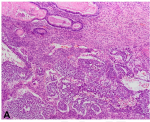PD-L1 expression in testicular germ cell tumors undergoing spontaneous regression
DOI:
https://doi.org/10.17305/bb.2024.10745Keywords:
Germ cell tumor, testis, spontaneous tumor regression, PD-L1, lymphocyte, biomarkerimmunotherapyAbstract
Spontaneous regression of testicular germ cell tumors is a well-known phenomenon; however, the precise mechanisms of spontaneous regression are still unknown. Our study aimed to investigate programmed death-ligand 1 (PD-L1) expression in spontaneously regressed testicular germ cell tumors, exploring the link between the immune response and spontaneous regression. From a sample of 356 testicular germ cell tumors, we singled out 5 completely regressed and 6 partially regressed tumors. In four out of six cases with partial regression, a residual seminoma component was found, while in the remaining two cases, an embryonal carcinoma component was found. Comparisons were made with 20 pure seminomas and 20 mixed germ cell tumors (MGCTs). A semiquantitative immunohistochemical analysis of PD-L1 expression in tumor cells and intra/peritumoral lymphocytes was performed. There was no PD-L1 expression in tumors with complete regression. All partially regressed tumors showed expression in intra/peritumoral lymphocytes within the tumor remnants. Expression was significantly more frequent in pure seminomas compared to MGCTs (P = 0.004). A positive correlation was demonstrated between the seminoma component and the proportion of PD-L1 positive lymphocytes, with a Kendall's Tau-b coefficient of 0.626 (P < 0.001). Tumor cells showed PD-L1 expression in three MGCTs within the embryonal carcinoma component. Our results support an immunological mechanism of spontaneous tumor regression, with the strongest potential in testicular tumors containing seminoma components. However, further research is necessary to determine the role of PD-L1 ligand more precisely in the microenvironment of spontaneously regressed tumors.
Citations
Downloads

Downloads
Published
Issue
Section
Categories
License
Copyright (c) 2024 Ivan Novak, Miroslav Tomić, Denis Mulabdić, Ivan Pezelj, Slaven Čiček, Igor Tomašković, Nino Sinčić, Božo Krušlin, Monika Ulamec

This work is licensed under a Creative Commons Attribution 4.0 International License.









